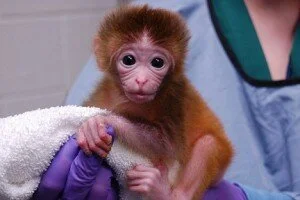For the first time, scientists have produced chimera monkeys, or monkeys composed of cells taken from more than one embryo.1
 Chimeras (i.e. animals that contain genetically distinct groups of cells from more than one organism) are important for studying embryonic development; however, until this breakthrough, research has largely been restricted to mice.
Chimeras (i.e. animals that contain genetically distinct groups of cells from more than one organism) are important for studying embryonic development; however, until this breakthrough, research has largely been restricted to mice.
In their initial attempts at creating chimeric monkeys, Shoukhrat Mitalipov and his fellow researchers employed the method that has been established to create chimeric mice. They took stem cells from monkey embryos at the stage of “pluripotency”—meaning that the cells are beyond the ability to turn into the placenta or the entire animal, but they can still transform into any type of bodily tissue—and introduced these cells into monkey embryos. These attempts, however, failed.
Instead, the researchers found success when they combined cells from two (or more) very early stage embryos, in which each individual embryonic cell was “totipotent.” Totipotent cells (unlike pluripotent cells) are able to create an entire animal as well as the placenta and other life-sustaining tissues. “The cells never fuse, but they stay together and work together to form tissues and organs,” said Mitalipov. “The possibilities for science are enormous.”
This research suggests that scientists have more to learn more about the biological pathways that restrict cells’ ability to differentiate and form different types of tissue in different organisms. If the laws that govern monkeys’ stem cells differ from those that govern mice, then scientists must consider that human stem cells may differ significantly, too.
The three chimeric rhesus monkeys, named Chimero, Roku and Hex, are said to be normal and healthy, and continue to reside at the Oregon National Primate Research Center at Oregon Health and Science University.
| Resources from Wiley on This Topic | |

|
Culture of Animal Cells: A Manual of Basic Technique and Specialized Applications, 6th Editionby R. Ian Freshney |

|
Animal Cell Culture: Essential Methodsby John M. Davis |
1. Tachibana, M., Sparman, M., Ramsey, C., Ma, H., Lee, H., Penedo, M., & Mitalipov, S. (2012). Generation of Chimeric Rhesus Monkeys Cell DOI: 10.1016/j.cell.2011.12.007